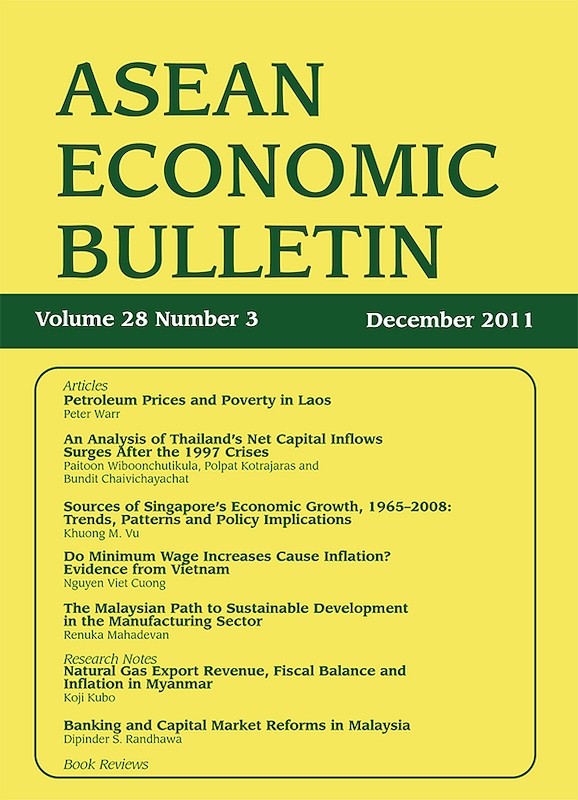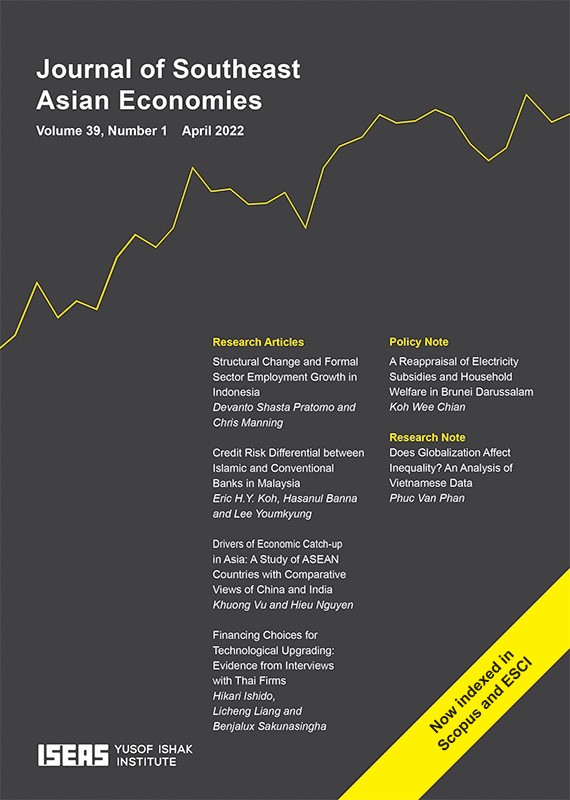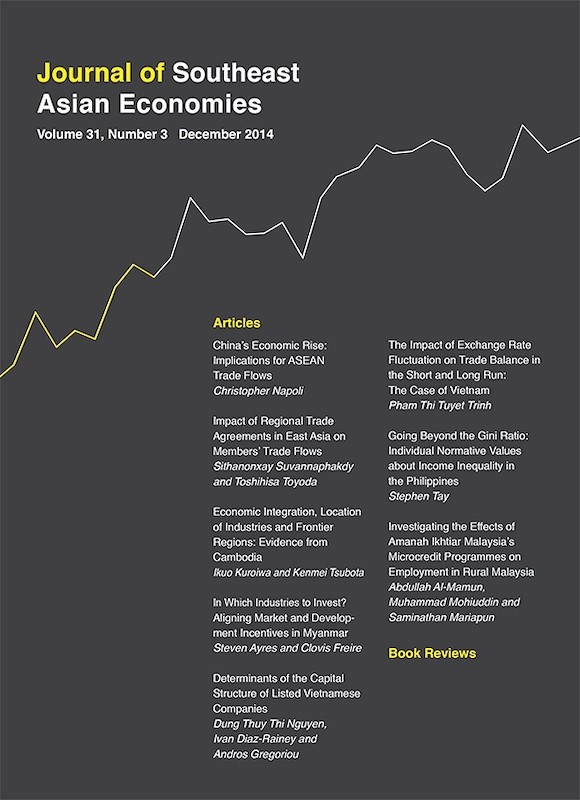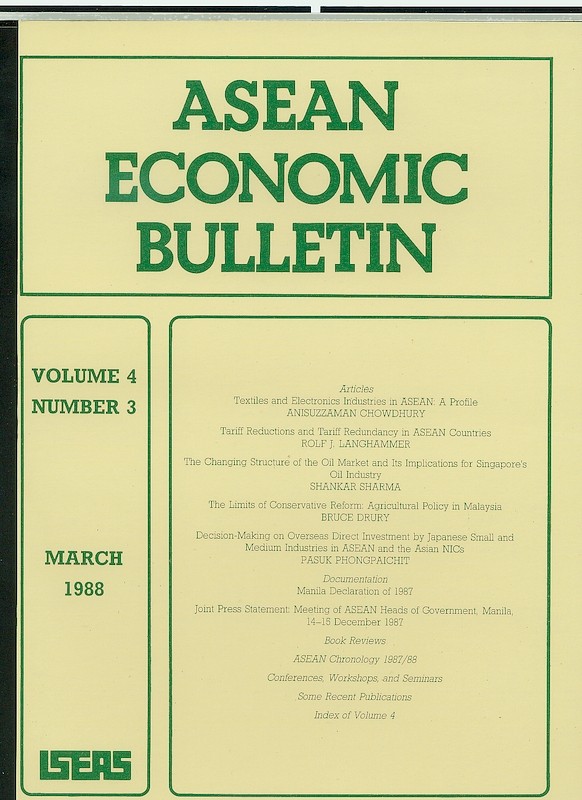Journal of Southeast Asian Economies Vol. 31/2 (Aug 2014). Policy focus on "Integrating Myanmar into the Global Economy"
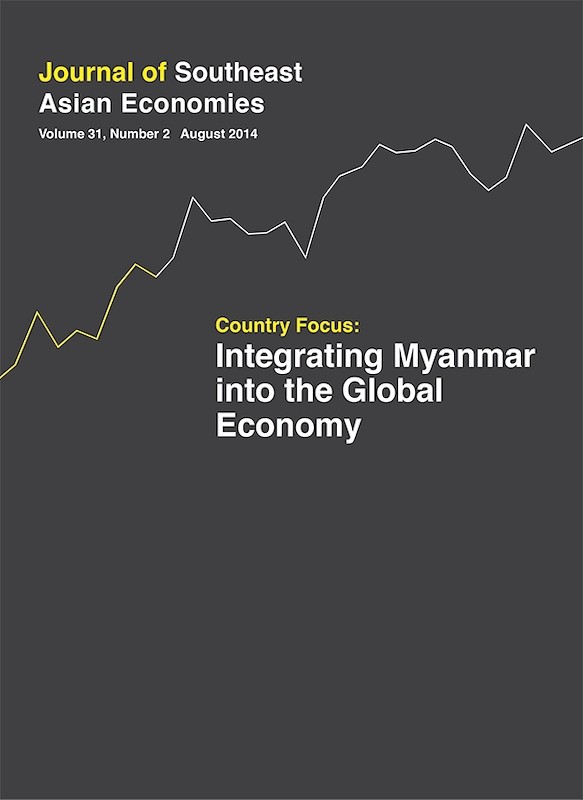
Tin Maung Maung Than, editor
Date of publication:
August 2014
Publisher:
Institute of Southeast Asian Studies
Number of pages:
180
Code:
AE31/2
Contents
-
Journal of Southeast Asian Economies Vol. 31/2 (Aug 2014). Policy focus on "Integrating Myanmar into the Global Economy"
[Whole Publication] -
Preliminary pages
- COUNTRY FOCUS ARTICLES
-
Introductory Overview: Myanmar's Economic Reforms, by Tin Maung Maung Than, author see abstractPresident Thein Sein’s government launched a series of political, economic and administrative reforms soon after assuming power in March 2011. The economic reform agenda emphasizes good governance, transparency and accountability while including measures for attracting foreign direct investment (FDI), liberalizing trade, enhancing regional economic cooperation, reducing the state’s economic role, boosting productivity and balancing equity with efficiency. A more systematic exposition of reforms is the government’s Framework for Economic and Social Reforms (FESR). With the removal of most of the Western punitive sanctions, liberalization of finance, banking, trade and investment sectors and replacement of the overvalued fixed exchange rate with a managed float, Myanmar, with its rich natural resources and virtually untapped market, has become the favoured emerging market for the international business community. However, the country’s economic transition is not going to be smooth as there are many structural and other problems inherited from decades of mismanagement and neglect, as well as socio-political challenges. Meanwhile, little research on problems and issues in the various economic sectors is available to the reformist government, whose lack of capacity makes it all the more difficult to institute reforms. However, the returning international financial institutions, Western government-linked aid agencies and private consultancies have brought in expertise to narrow the information gap. In this special edition on Myanmar reforms, issues related to external trade, exchange rate, finance, banking, business environment and potential economic strategies, which are vital components of the reform agenda and crucial for Myanmar’s sustained growth, are analysed.<br><br>
-
Five Growth Strategies for Myanmar: Re-engagement with the Global Economy, by Toshihiro Kudo, Satoru Kumagai, So Umezaki, authors see abstractAfter decades of isolation, Myanmar is now actively re-engaging with the global economy. For successful re-engagement, Myanmar needs to implement comprehensive economic reforms based on a shared vision of long-term economic development characterized by human-centred, sustainable, pro-poor, inclusive, high and balanced economic growth. In this paper, we propose five growth strategies: an “Agriculture Plus Plus” strategy; an export-oriented strategy; a foreign direct investment driven strategy; a two-polar growth strategy; and a domestic economic corridors development strategy. These strategies are used as guides to translate wide-ranging development agendas into a set of implementable policies, programmes, and projects.<br><br>
-
Myanmar's Trade and Its Potential, by Benno Ferrarini, author see abstractThe paper estimates Myanmar’s export potential based on bilateral export patterns observed for six countries in Southeast Asia. Against that benchmark and controlling for outliers, Myanmar is found to be trading at about 15 per cent of its potential. The bulk of this gap is explained by low trade with industrialized countries. It is conjectured that economic reforms and integration with the world economy are likely to close this gap to potential rather<br>swiftly, particularly if Myanmar can manage to capitalize on its favourable predisposition to international trade.<br><br>
-
Foreign Exchange Market Reform in Myanmar: Achievements and Challenges, by Koji Kubo, author see abstractMyanmar has made an overt move from a de facto multiple exchange rate system to a managed floating exchange system, but the impact of reform of the foreign exchange market on the economy remains unclear. While reform measures have alleviated segmentation within the foreign exchange market, they have not completely driven out transactions that take place within a pre-existing parallel market. Such transactions may be cost efficient for individual<br>firms, but could hinder the development of the financial sector.<br><br>
-
Banking and Financial Regulation and Reform in Myanmar, by Sean Turnell, author see abstractFor fifty years Myanmar has been without a properly functioning financial system. This absence has been a significant brake on the efficacy of reform in Myanmar, on foreign investment, and on the ability of Myanmar firms to raise the capital they need to grow and prosper. Since 2011, however, critical but limited reforms have been put in place by Myanmar’s new government. These include reforms to Myanmar’s exchange rate arrangements, and the granting of a degree of formal autonomy to the country’s central bank. Other reforms, pending but not yet implemented, include allowing a role for foreign banks, and making changes to the broader regulatory arrangements that currently greatly constrain the operations of Myanmar’s banks. In recent times much progress has been made in creating the financial institutions Myanmar needs to achieve transformational growth, but much remains to be done.
-
Myanmar's Economic Institutions in Transition, by Jared Bissinger, author see abstractImproving the business environment has been a major aim of Myanmar’s reforms. However, the formal and informal economic institutions that govern exchange and shape the business environment changed significantly under a half-century of socialist and military government. The socialist leadership eliminated many market-supporting institutions made unnecessary because economic activity was to be state planned. Under this framework, personal exchange became dominant and control of economic life widespread. The military government revived market exchange, but many institutions from the socialist era remained and continue to constrain private business today. Thus, the strict economic controls, arbitrary policy-making and lack of processes that affect businesses in present-day Myanmar have direct institutional links with former regimes. They distort the structure of the economy, incentivize clustering in particular sectors and promote the use of networks and personal exchange. As other countries have shown, successful reform is a long process requiring more than changes in the formal institutions of regulation.
- ORIGINAL ARTICLES
-
Shifts in Exchange Rate Regimes and Inflation Persistence in Vietnam, 19922010, by Nguyen Tran Phuc, Nguyen Duc-Tho (Tom), Jen Je Su, Tarlok Singh, authors see abstractA number of studies have found that more flexible exchange rate regimes tend to be associated with greater inflation persistence. This paper investigates whether this finding is applicable to Vietnam from 1992 to 2010. We find no evidence to suggest that inflation persistence in Vietnam was systematically higher under a “soft” peg exchange rate regime than under a “hard” peg. Rolling regressions suggest that inflation persistence peaked during 2004 to 2007, when Vietnam was governed by what may be characterized as a hard-peg regime.
-
A New Electricity Tariff in Brunei Darussalam: Welfare Implications for Households, by Koh Wee Chian, author see abstractElectricity prices in Brunei are highly subsidized, placing a heavy fiscal burden on the government budget. Prior to 1 January 2012, the primary electricity tariff in the residential sector was based on a Declining Block Tariff structure, and non-poor households enjoyed a disproportionately large share of total electricity subsidies. The government has since implemented a new electricity tariff in the residential sector based on an Increasing Block Tariff. The main objective of this paper is to evaluate the welfare impact for households. It is estimated that about 80 per cent of households benefit from the new tariff, with poor households enjoying a larger percentage gain compared to the old tariff. However, total electricity subsidies remain roughly unchanged under the new tariff; in addition, non-poor households continue to enjoy a substantial proportion of the subsidies. There is still much to be done to tackle the high fiscal costs of subsidies and the problem of distribution distortion.
-
Productivity, Efficiency and Privatization in the Malaysian Water Industry, by Lee Yoong Hon, Tan Hui Boon, Cassey Lee, authors see abstractThis paper analyses efficiency within the Malaysian water sector using the Data Envelopment Analysis (DEA) approach and the Malmquist Total Factor Productivity (TFP) Index. The results of the DEA show that the sector’s mean technical efficiency was about 65 per cent over a ten-year period (1999 to 2008), which means that there is significant room for improvement in the area of resource utilization, whereby the sector can expand by 35 per cent whilst continuing to use the same amount of resources. The findings also indicate that Pulau Pinang state has the most efficient utilization of water and can therefore serve as a benchmark for optimal performance. The TFP analysis shows that the sector lags behind in the area of technological improvements, confirming an ongoing problem of inadequate capital investment. The findings indicate a positive relationship between efficiency and profitability and a negative relationship between efficiency and tariff rates. The relationship between privatization and efficiency, however, cannot be ascertained solely from the findings of this paper.
-
Regional Economic Integration in ASEAN: How Far Will It Go?, by Shahriar Kabir, Ruhul A Salim, authors see abstractThe Association of South East Asian Nations (ASEAN) is among several regional blocs that have received praise from economists for making significant progress towards developing intra- and extra-regional economic relationships. However, opinions differ over the extent of ASEAN’s potential for integration. This paper reviews the performance of and prospects for the group’s intra- and extra-regional integration. It also reviews the performance of individual members in order to assess whether ASEAN integration could potentially lead to a monetary union in the future. We provide an overview of trade performance and a comparison of three macroeconomic variables: inflation; interest; and exchange rates. We observe that ASEAN members are in a favourable position to form a strong economic zone in the near future, but adopting a common monetary policy is less plausible.
- BOOK REVIEWS
-
BOOK REVIEW: Emerging Knowledge Economies in Asia: Current Trends in ASEAN-5, edited by Dessy Irawati and Roel Rutten., by Cassey Lee, author
-
BOOK REVIEW: Vietnam's Economic Entities in Transition, edited by Shozo Sakata., by Guanie Lim, author
-
BOOK REVIEW: Asian and Pacific Cities: Development Patterns, edited by Ian Shirley and Carol Neill, by Hans Hortig, author
-
BOOK REVIEW: Trade and Employment in Asia, edited by Niny Khor and Devashish Mitra, by Robert L Curry, Jr., author

